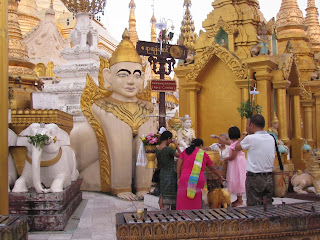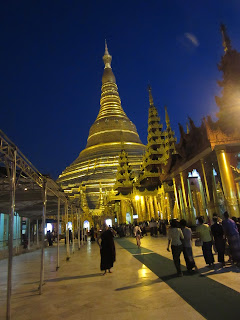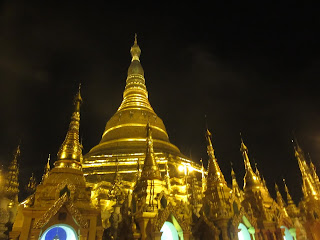I thought the previous post would be too long if I also included our visit later on November 15th to Yangon's most famous sight,
Shwedagon Pagoda, as I wanted to include lots of photos to do it justice. Forgive me if you feel I've included too many photos in this post but I wanted to remember Schwedagon's magnificence and this was the best way.
After wandering around the Bogyoke Aung San Market for a while, we took
another taxi, this time to visit the pagoda as it was located northwest of the city center.
Lots of rules for foreigners at Schwedagon Pagoda.
We decided to carry our shoes rather than leave them at the entrance. We discovered later that some pagodas do not allow visitors to even carry shoes inside,
This map gives you a sense of how immense Schedago Pagoda is.
The first thing we saw when we arrived via elevator at the top of the hill where Schedagon is located was this Bodhi tree. The tree is significant for Buddhists as it was under the tree where Buddha gained enlightenment.
Schwedagon Pagoda is not only the religious center of Yangon
but also the cultural and spiritual heart of Myanmar
itself. I read that Buddhists come from all over the country to this historic
site to venerate the Buddha and to breathe in the meditative spirit of this
sacred shrine. Over the centuries, the ancient pagoda has suffered significant
damage from earthquakes, and has been continuously reconstructed and extended
by successive rulers. The tradition of gilding the stupa was begun by a fifteenth century queen who provided her body weight in gold and was continued by subsequent
rulers. We saw pilgrims decorating the pagoda so the tradition continues to
this day.
An estimated 60 tons of gold, or 8,688 solid gold slabs, is
thought to adorn the pagoda which rises 322 feet above its base on Singguttara
Hill and is 646,000 square feet in size. Kay, I thought of you when I read that Shwedagon contains more
gold that the vaults of the Bank of England! The tip of the stupa is set with
5,448 diamonds and 2,317 rubies, sapphires and topaz but who’s counting?! A
huge emerald sits in the middle to catch the first and last rays of the sun.
There are more than 100 other buildings, including smaller
stupas, pavilions and administrative halls that surround the central stupa.
Standing before it was humbling.
Quite apart from its spiritual importance for the entire
nation, Shwedagon Pagoda also mirrors political turning points in the
history of Myanmar .
It was here, for instance, that students gathered in 1920 to protest against
their British colonial rulers and it was here that freedom fighter Aung Sun
and later his daughter, Aung San Sui Kyi, who just won the national election,
held their first speeches, delivered to ecstatic audiences. In August, 1988, Aung
San Sui Kyi addressed another mass meeting
of 500,000 people at the stupa, demanding democracy from the military.
In September 2007, during
nationwide demonstrations against the military regime and its recently enacted
price increases, protesting monks were denied access to the pagoda for several
days before the government finally relented and permitted them in.
Progression of people all carrying flowers.
It was enchanting seeing the pagoda in a new light as day turned to dusk and then again later to dark. I don't know how many times we wandered around the pagoda complex to see it in as many lights as we could.
There was no wind to rustle the bells.
The Bell of King Singu - no, I don't know who he is either!
I hope my photos have helped convey the almost mesmerising beauty of Schwedagon Pagoda. It was without a doubt one of the highlights of our trip.
Posted on 11/29 from Kuala Lumpur, Malaysia.

























































































Lovely as the sun went down. Lil Red
ReplyDelete